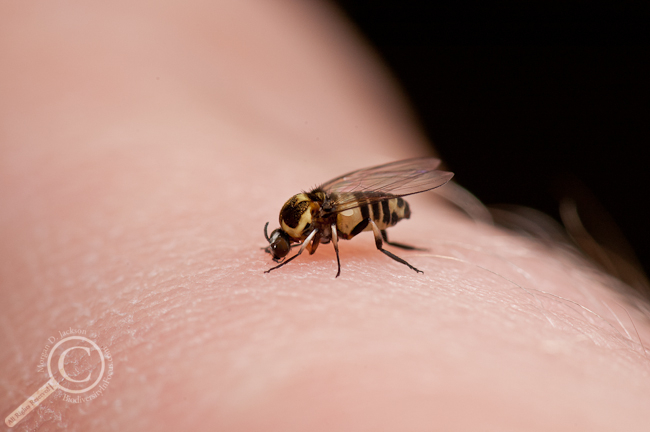American Thanksgiving not only marks the beginning of left-over turkey sandwich season, but has also come to represent the official start of the Holiday Season™. Traditionally rung in with the rampant purchasing of sale-priced items, the beginning of Holiday Season™ is now celebrated instead with Black Fly Day. This year, in preparation for ugly sweater parties and more family gatherings than should ever occur in such short succession, I present to you 6 fun facts about black flies that will keep your friends and family utterly enchanted!

Simulium (Psilopelmia) bicoloratum from Ecuador (Simuliidae) feasting on my blood.
- Most people may know them simply as black flies, but some regions have developed their own nomenclature for our celebrated guests.
- White Sox – Alaska, based on pest species with white legs, not the baseball team unfortunately,
- Cholera Gnat – Virginia, blamed for transmitting “chicken cholera” among chickens and turkeys, which isn’t actually cholera, but probably a parasitic protozoan. Love in the Time of Cholera Gnats would make an excellent title for a black fly biologist’s biography however,
- River Leach – Widespread, for the tendency of larval black flies to get stuck to swimmer’s legs, ironically without the blood-sucking at this point. And my all-time personal favourite,
- Submarine Spiders – New York, based on the erroneous idea that black fly larvae used their silken nets to catch baby trout; they are in fact filter feeders, and spin their nets to look fabulous and hold themselves in place while they undergo metamorphosis.
- The 2015 Nobel Prize for Physiology or Medicine will be awarded in part to Dr. William Campbell, who helped develop ivermectin, a drug used to combat the roundworm that causes river blindness. River blindness, also known as Onchocerciasis, is transmitted by black flies, similar to how mosquitoes transmit malaria, and infects up to 25 million people worldwide. Thanks to Dr. Campbell’s work, and the drug company he worked for (Merck) giving the drug away for free around the world, river blindness infection rates are being reduced around the world, with some areas even achieving eradication of this debilitating disease.
- At least 4 species of North American black flies have given up sex, and males, entirely, and instead reproduce via parthenogenesis. 3 of these species have also eschewed flying and eating as adults, making one wonder what the point of life truly is. Regardless, these unisexual flies emerge from their underwater pupae with eggs fully developed and ready to begin the cycle of isolation and loneliness all over again within days of adulthood.
- While the majority of female black flies require a blood meal to protein-load in preparation for making eggs, roughly 10% of North American species no longer have the weaponry required to draw blood. Interestingly, many of these species live at high altitudes or northern latitudes, and have perhaps gone vegan not by choice, but by circumstance. Alternatively, having found their zen and become true pacifists, they chose a secluded life away from society to sing Kumbaya and grow hemp without contemptuous looks from other black flies.
- When it comes to host-choice in black flies, the toes knows. Blood-feeding black flies separate into two categories: those that feed on birds, and those that feed on mammals, and you can almost always recognize which is which by looking at the shape and form of the female’s tarsal claws. Species that feed on mammals have a simple claw adapted for moving through and holding onto hair, while females that feed on birds have an extra thumb-like lobe at the base of their claws that is perfectly adapted for fingering feathers. Males, on the other claw, simply have to hold on to females, and thus have reduced claws and a special structure called the grappling hook. No, seriously, that’s its actual scientific name: the grappling hook. Flies: more hardcore than any action movie ever produced, Die Hard included.
- For most species of black flies, as long as they can hold on to the host, any blood will do. In fact, the only species in North America that is not considered to be a generalist parasite is Simulium annulus, which oddly enough appears to be a specialist on the Common Loon (Gravia immer). Why the loon is so lucky to have its own black fly pest is unknown, but the flies seem to preferentially recognize the shape of a loon sitting on its nest, and then use chemical cues from the bird’s feather oils to get where they want: the bird’s face, where the feathers are smaller and easier to subvert. Black fly numbers can be so fierce at times that loons will abandon their nests to escape their black fly tormentors, causing local loon populations to crash in particularly bad years.
And there you have it, enough casual conversation starters to get you through those awkward moments before the egg nog is served. If you’ve got a black fly story of your own that you rely upon for similar social situations, please share it in the comments below, and ’til next year, Happy Black Fly Day!
—
Most of these facts are courtesy of the Black Fly Bible, The Black Flies (Simuliidae) of North America, by Adler, Currie, and Wood.

Did you know that the Badger Brewery in Dorset, England make a beer called Blandford Fly? It’s named after Simulium posticatum, known in England as the Blandford Fly. The label describes the beer as ‘subtly spiced for extra bite’. I’ve had it on occasion and it is quite good.
Great initiative!